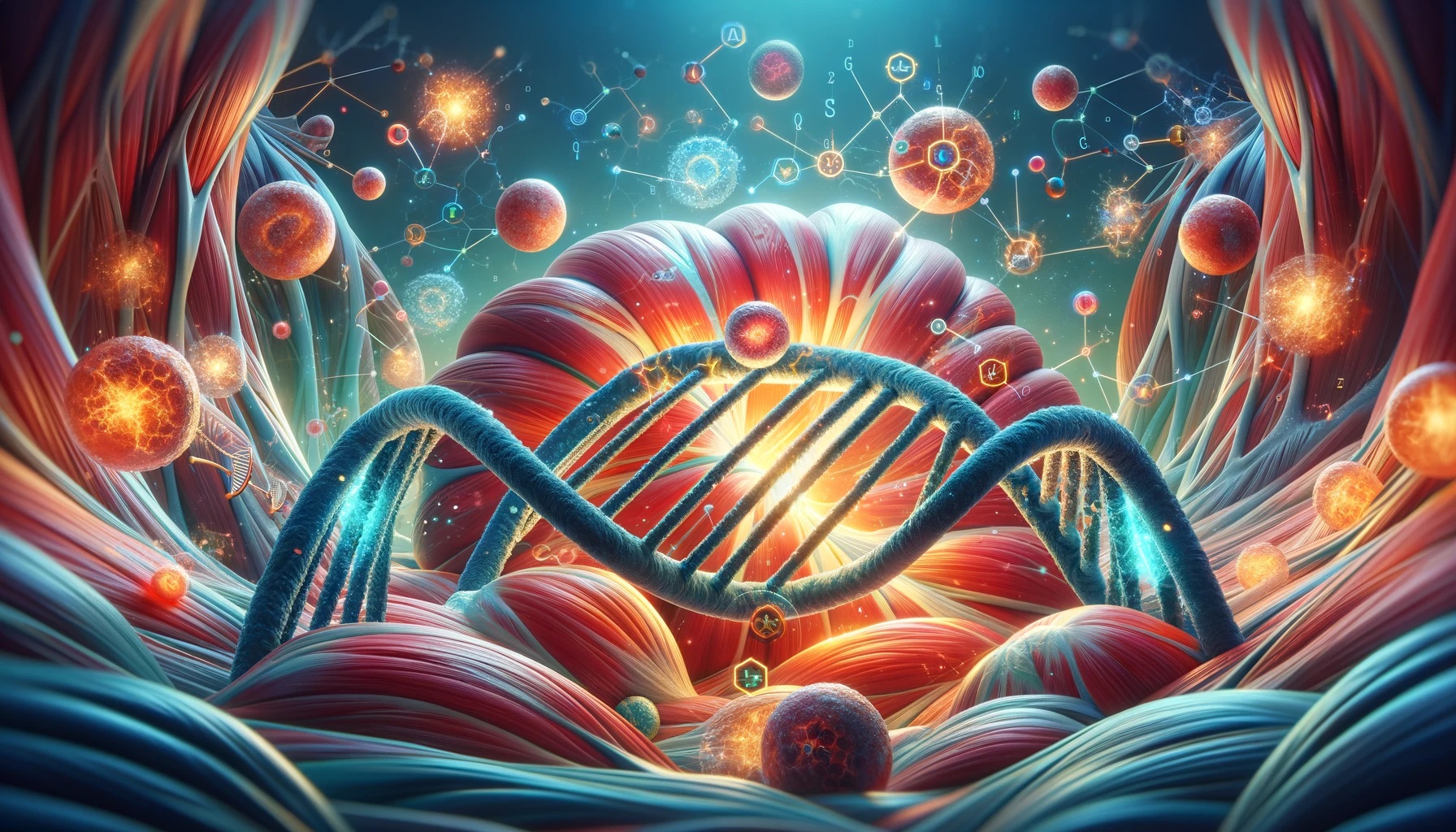· fitness · 19 min read
Unveiling Muscle Growth: The Role of Damage & Repair
Explore the fascinating process of muscle growth through the lens of damage and repair, highlighting the pivotal role of satellite cells and resistance training in facilitating muscle hypertrophy.

In This Post
The Fact Why Should I Care How To Put In Action Start Tomorrow Guide How does it effect my ability to focus How does it impact my daily life How does it help me make friends How does it help me manage stress How does it effect my mood Summary: Remember Refresher Checklist The Full Research Article CitationsPrint Out The Tomorrow Checklist!
Sign up for our newsletter and receive a copy today, so that, you can start tomorrow! Or the next day, or the day after that. I forget everything and starting things is hard at least for me so these checklists are godsend.
Print Out The Remember Refresher Checklist!
Sign up for our newsletter and download your own copy of the Remember Refresher Checklist, so that, you can easily put it on your fridge and help you stay on target towards your WHY. Every little bit helps.
Introduction
The Fascinating Dynamics of Muscle Growth
The journey to building muscle, often known as muscle hypertrophy, is a marvel of biology that extends far beyond the dumbbells and protein shakes. It involves a complex process of muscle damage and repair, driven by mechanical stress and anabolic signaling resulting from resistance training. When we engage in strength training or any form of exercise that puts our muscles under stress, we’re not just working out; we’re triggering a biological cascade that leads to muscle growth.
Muscle adaptation is the body’s natural response to the stress of exercise, making our muscles stronger and more capable of handling such stress in the future. This process is facilitated by several factors, including satellite cell proliferation, protein synthesis, and post-exercise recovery mechanisms.
Here’s a simple checklist to kick-start your muscle growth journey through the right kind of stress:
- Engage in regular resistance training, focusing on exercises that target multiple muscle groups.
- Incorporate a variety of exercises, including those that involve eccentric contractions, to induce myofibrillar damage effectively.
- Ensure adequate nutrition to support protein synthesis and muscle repair.
- Prioritize post-exercise recovery, allowing your muscles sufficient time to repair and grow.
- Monitor your progress and adjust your workout intensity to avoid overtraining syndrome.
Overview of Muscle Damage and Repair Mechanisms
Underneath the surface of our skin, every time we lift weights or engage in any form of resistance training, our muscle fibers go through a process of damage, known colloquially as myofibrillar damage. This might sound alarming, but this damage is precisely what prompts our muscles to grow stronger and larger. The process is a striking example of how our bodies adapt to the demands we place on them, encompassing everything from microscopic cell signaling pathways to the visible growth of muscle mass.
Muscle repair and hypertrophy depend significantly on satellite cell proliferation. These cells are akin to the unsung heroes of muscle growth, lying dormant until they’re awakened by the stress of exercise. Once activated, they help repair damaged muscle fibers by donating nuclei, a process critical for protein synthesis and muscle fiber growth.
Additionally, elements such as mitochondrial biogenesis, sarcoplasmic hypertrophy, and myogenic regulatory factors play critical roles in the repair mechanisms that lead to muscle growth. Nutrition and rest are, without a doubt, crucial in facilitating these repair processes, emphasizing the importance of a well-rounded approach to muscle building that goes beyond just lifting weights.
Understanding the delicate balance between muscle damage and repair is essential for anyone looking to build muscle effectively and sustainably. It invites us to view muscle growth not just as a product of our workouts, but as a fascinating physiological process that highlights the incredible adaptability of the human body.
The Science Behind Muscle Damage
Understanding Exercise-Induced Muscle Damage
When we engage in physical activities, especially those that challenge our muscles like strength training or intense aerobic exercises, our muscle fibers undergo a form of stress known as exercise-induced muscle damage. This damage is primarily the result of mechanical stress put on the muscles during eccentric contractions, where the muscle lengthens under tension, such as when lowering a weight during a bicep curl.
This muscle damage might sound negative, but it’s a natural and necessary step towards muscle growth and adaptation. The process leads to muscle soreness typically experienced a day or two after a new or intense workout, often referred to as Delayed Onset Muscle Soreness (DOMS). This soreness is a physical sign of your body adapting to the exercise, preparing your muscles to perform better in future workouts.
How Muscle Damage Spurs Growth
The relationship between muscle damage and growth can be summarized through a biological response process that involves repair and adaptation mechanisms. Here’s a simplified checklist that outlines this dynamic process:
- Mechanical Stress: Resistance training introduces stress to the muscles through activities that cause muscular contraction.
- Muscle Damage: This stress leads to micro-tears within the muscle fibers, known as myofibrillar damage.
- Inflammatory Response: The body responds to this damage by activating an inflammatory process that signals repair mechanisms.
- Satellite Cell Activation: Satellite cells, which are crucial for muscle repair, are activated to proliferate and differentiate into mature muscle cells.
- Muscle Repair and Growth: These cells help repair the damaged muscle fibers and contribute to muscle hypertrophy (growth).
- Adaptation: Over time, this cycle of damage and repair strengthens the muscle, making it more resilient to similar stress in the future.
Critical to this muscle adaptation process are the factors that influence recovery, such as proper nutrition, adequate rest, and the strategic implementation of resistance training. An optimized balance of these elements promotes effective post-exercise recovery, protein synthesis, and ultimately, muscle hypertrophy.
Understanding this cycle explains why progressively overloading the muscles through varying your workouts, increasing weights, or changing exercises is essential for continued muscle growth. It also highlights the importance of recovery phases, emphasizing that muscle repair and strengthening primarily occur outside the gym during rest periods.
In summary, exercise-induced muscle damage is a fundamental aspect of the muscle growth process, serving as a trigger for muscle repair and hypertrophy. Through careful training and recovery strategies, these mechanisms can be harnessed to achieve significant improvements in muscle strength and size, highlighting the critical role of muscle damage in the broader context of exercise physiology and muscle adaptation.
Satellite Cells – The Unsung Heroes
The Critical Role of Satellite Cells in Muscle Repair
It’s like your muscles have a secret team of mechanics, ready to fix them up after a tough workout. These mechanics are called satellite cells. They play a key role when it comes to repairing and growing your muscles. Imagine every time you lift weights, go for a run, or challenge your muscles in any way, small damages occur in the muscle fibers. This is where satellite cells spring into action.
Satellite cells are a type of stem cell. This means they can transform into the kind of cells your muscles need to heal and get stronger. When your muscles are damaged, satellite cells multiply and go to the damaged area. They then fuse with the muscle fibers, helping them to not only repair but also grow bigger and stronger - this is what we call muscle hypertrophy. It’s like the satellite cells are the body’s response team, ensuring your muscles bounce back stronger after each workout.
Satellite Cells Activation During Resistance Training
When you engage in resistance training, you’re not just working your muscles; you’re also waking up those satellite cells. Here’s a checklist to maximize satellite cell activation during your resistance training sessions:
- Increase the Intensity Gradually: Doing higher intensity workouts too fast might increase the risk of injury. Start slowly, then gradually increase intensity.
- Focus on Eccentric Contractions: Exercises that emphasize the lengthening of the muscle, like lowering weights slowly, can lead to more muscle damage, which is a key trigger for waking up satellite cells.
- Vary Your Workouts: Incorporating a variety of movements and types of resistance training can expose your muscles to different stresses, enhancing satellite cell activity.
Resistance training initiates a fascinating cascade of events at the cellular level. As muscles undergo strain and micro-damages, satellite cells are mobilized. They proliferate and differentiate into myoblasts, cells that will eventually mature into new muscle fibers or repair existing ones. This process is not just about repairing damage. It’s a critical step towards muscle adaptation, allowing your muscles to better handle the same stress in the future. Think of it as your muscles learning from the workout, getting smarter, and preparing for the next challenge.
Moreover, this activation and proliferation of satellite cells are influenced by exercise physiology factors such as the type of exercise, the intensity, and even the rest periods between sets. Engaging in strength training, for example, triggers anabolic signaling pathways that promote protein synthesis and satellite cell activation, leading to myonuclear addition where new nuclei are added to muscle fibers, supporting their growth and function.
In essence, satellite cells are at the heart of muscle repair and growth. By understanding their role and how to stimulate their activity through proper resistance training, you can optimize your workouts for effective muscle hypertrophy and adaptation.
The Repair Process and Muscle Development
Muscle repair and development are fascinating processes that involve several stages, each crucial for achieving optimal muscle growth. Understanding these stages not only helps in optimizing your workout routine for better results but also in ensuring that your muscles recover properly, leading to more effective and sustainable muscle growth over time.
Stages of Muscle Repair and Growth
When you engage in intense physical activity, especially resistance training, your muscle fibers undergo microscopic damage. This damage, though initially might sound negative, is actually the first step towards achieving muscle hypertrophy. Here’s a simplified rundown of what happens during the muscle repair and growth process:
- Damage Occurs: Resistance training, particularly movements that involve eccentric contractions, leads to myofibrillar damage within the muscle fibers.
- Inflammation: Following the damage, there is a natural inflammatory response that mobilizes various cell types to the injured site.
- Satellite Cell Activation: Satellite cells become activated, proliferate, and differentiate to repair the damaged muscle fibers.
- Repair and Growth: The satellite cells fuse to muscle fibers, donating their nuclei (myonuclear addition), which is essential for muscle fiber repair and growth.
- Remodeling: Over time, with consistent training and proper recovery, these muscle fibers adapt, becoming stronger and often larger in response to the mechanical stress.
It’s this cycle of damage, repair, and adaptation that leads to muscle hypertrophy, assuming all other factors such as nutrition and rest are adequately addressed.
Influence of Nutrition and Rest on Recovery
To support the muscle repair and growth process, two critical factors need to be emphasized: nutrition and rest. Here’s a quick checklist to ensure you’re supporting your recovery effectively:
- Protein Intake: Consume enough protein to support protein synthesis, which is vital for muscle repair.
- Adequate Calories: Ensure you’re getting sufficient calories to fuel the repair process and muscle growth.
- Hydration: Stay well-hydrated to support overall cellular function and recovery.
- Quality Sleep: Aim for 7-9 hours of quality sleep per night to foster optimal recovery and growth hormone release.
Integrating Resistance Training for Optimal Muscle Development
Integrating resistance training into your routine is crucial for stimulating muscle hypertrophy. However, the key is not just to train hard but to train smart. Here are a couple of considerations:
- Progressive Overload: Gradually increase the weight, frequency, or intensity of your workouts to challenge your muscles continually.
- Variety: Incorporating a mix of strength training exercises targeting different muscle fiber types can lead to more comprehensive development and prevent plateaus.
Avoiding Overtraining: Balancing Stress and Recovery
Overtraining syndrome is a real concern in the pursuit of muscle development. It results when the balance between training stress and recovery is not maintained. Here are a few signs to watch out for:
- Persistent muscle soreness
- Declining performance
- Increased susceptibility to illnesses
- General fatigue
Listening to your body, ensuring sufficient recovery time, and maintaining a well-rounded training program are essential strategies for avoiding overtraining while still progressing towards your muscle development goals.
In summary, muscle repair and growth are processes influenced by training-induced damage and the subsequent repair mechanisms, including satellite cell proliferation and myofibrillar repair. Nutrition, rest, and a well-planned resistance training program, along with a mindful approach to balancing stress and recovery, are fundamental to achieving optimal muscle development while maintaining overall health and well-being.
Beyond the Basics
As we delve into the future of muscle repair research and the burgeoning innovations aimed at enhancing satellite cell activity, we encounter exciting possibilities that could revolutionize the way we approach muscle growth and recovery. Understanding these advancements is crucial for both fitness enthusiasts and professionals alike, as they signal a shift towards more efficient and effective methods of achieving muscular hypertrophy.
Future Directions in Muscle Repair Research
The field of muscle repair and hypertrophy is continuously evolving, with scientists exploring various avenues to better understand and enhance the muscle repair process. One key area of focus is the intricate mechanisms of satellite cell proliferation and their role in muscle adaptation. As we gain deeper insights into these processes, future research may offer novel strategies for optimizing muscle growth and recovery.
- Targeted Gene Therapy: Innovations in gene therapy hold promise for directly influencing the muscle repair mechanisms, potentially offering new ways to stimulate myofibrillar damage repair and myogenic regulatory factors more efficiently.
- Enhanced Anabolic Signaling: By understanding the cell signaling pathways involved in muscle growth, researchers are looking into ways to enhance anabolic signaling, thus improving protein synthesis and mitochondrial biogenesis.
- Customized Training Regimens: With advances in exercise physiology, future research could lead to more personalized resistance training programs that cater to individual muscle fiber types, optimizing strength training outcomes.
Innovations in Enhancing Satellite Cell Activity
Satellite cells play a crucial role in post-exercise recovery and muscle hypertrophy. Emerging technologies and methodologies aim to boost the activation and effectiveness of these cells, offering new pathways to muscle growth.
- Advanced Biomechanical Stimulation: Techniques involving mechanical stress, such as eccentric contractions, are being refined to more precisely activate satellite cell proliferation and sarcoplasmic hypertrophy.
- Nutritional Interventions: Research into the effects of specific nutrients on satellite cell activity might lead to dietary recommendations that support enhanced muscle repair and growth.
- Stem Cell Research: Exploring the potential of stem cells to improve satellite cell function could offer groundbreaking advances in muscle regeneration and hypertrophy.
Checklist for Maximizing Muscle Growth and Recovery Through Satellite Cell Activation:
- Incorporate resistance training with a focus on eccentric contractions to stimulate satellite cell proliferation.
- Follow a balanced diet rich in nutrients that support protein synthesis and muscle repair.
- Stay informed about the latest research and technologies aimed at enhancing satellite cell activity and muscle hypertrophy.
- Consider personalized training regimens that cater to your unique muscle fiber composition and recovery needs.
- Monitor your body’s response to training and recovery strategies to avoid overtraining syndrome and ensure optimal muscle adaptation.
As we explore these exciting future directions and innovations, it’s clear that the field of muscle growth and repair is on the brink of significant breakthroughs. By staying informed and adopting evidence-based practices, individuals can make the most of these advancements to achieve their fitness goals.
FAQs: Unraveling Muscle Damage and Satellite Cell’s Role
In this segment of our exploration into muscle growth, we address some commonly asked questions that reflect the curiosity surrounding exercise-induced muscle damage, the role of satellite cells in muscle repair, and the impact of overtraining on muscle growth.
How Does Exercise Indicate Muscle Damage?
When you exercise, especially during resistance training or strength training, your muscles undergo a variety of stressors that lead to muscle damage. This is primarily caused by eccentric contractions where the muscle lengthens under tension, such as when lowering weights. This type of contraction is known to cause more significant micro-tears and myofibrillar damage within the muscle fibers.
Checklist for Identifying Exercise-Induced Muscle Damage:
- Increased muscle soreness a day or two after your workout, known as delayed onset muscle soreness (DOMS).
- Temporary decrease in muscle strength.
- Swelling in the exercised muscles.
- Elevated levels of creatine kinase in the blood, an enzyme released with muscle damage.
Understanding that this muscle damage is a catalyst for muscle hypertrophy and strength training adaptations helps embrace the soreness as a part of the growth process.
What Role Do Satellite Cells Play in Muscle Repair?
Satellite cells are crucial for muscle repair and growth. Located on the outer surface of muscle fibers, these cells spring into action following muscle damage. They proliferate and differentiate into myoblasts that fuse with damaged muscle fibers or with each other to form new muscle protein strands or repair existing ones. This process is central to muscle hypertrophy and post-exercise recovery, facilitating the increase in muscle size and strength.
- Muscle adaptation relies heavily on the activation and functionality of satellite cells.
- Satellite cell proliferation is stimulated by the mechanical stress and myogenic regulatory factors activated during and after resistance training.
- Effective recovery and nutritional support enhance satellite cell’s role in muscle repair.
Can Overtraining Affect Muscle Growth?
Overtraining syndrome is a real concern in the fitness community, particularly among those engaged in high-intensity strength training or resistance training programs. It occurs when there’s an imbalance between training and recovery, where the stress from overtraining exceeds the body’s ability to recover.
Checklist for Avoiding Overtraining and Promoting Muscle Growth:
- Ensure adequate rest and recovery time between workouts.
- Listen to your body’s signals and take breaks when experiencing excessive fatigue or decline in performance.
- Maintain a balanced diet to support recovery and muscle growth.
- Incorporate variety in your workouts to prevent repetitive stress on the same muscle groups.
- Prioritize sleep, as it is crucial for recovery and muscle repair.
Overtraining can significantly impede muscle growth by causing persistent muscle soreness, reducing muscle strength, altering hormonal profiles negatively, and increasing the risk of injury. Balancing exercise with proper rest and recovery is essential for sustaining muscle growth over time.
Through understanding these aspects, fitness enthusiasts can better navigate their journey towards achieving significant muscle hypertrophy while maintaining overall muscle health and preventing overtraining.
Embracing the Role of Muscle Damage in Strength and Development
Throughout this exploration of the intricacies behind muscle growth, we have journeyed through the scientific processes that transform stress and damage into strength and expansion. Recognizing the role of muscle damage in strength and development not only broadens our understanding but also enhances our approach to fitness and overall physical health.
Muscle damage, a seemingly counterintuitive contributor to muscle development, is a crucial step in achieving muscle hypertrophy. It serves as a catalyst for a series of cellular responses, leading to muscle repair, adaptation, and growth. Resistance training, in particular, is adept at inducing this beneficial damage, strategically tearing muscle fibers to pave the way for stronger and larger muscles. This process, accompanied by anabolic signaling, fuels muscle regeneration and expansion.
The unsung heroes in this process, satellite cells, spring into action following muscle damage. Their activation and proliferation are pivotal for repairing and adding new nuclei to muscle fibers, which is essential for muscle growth. Satellite cell activity is a prime example of the body’s remarkable ability to adapt and fortify itself in response to imposed demands.
To maximize the gains from our training efforts, understanding the balance between exercise-induced stress and recovery is essential. Here’s a simple checklist to ensure we are on the right path:
- Incorporate a Variety of Exercises: Engage in resistance training that includes both eccentric contractions and concentric movements to induce myofibrillar damage effectively.
- Prioritize Nutrition: Fuel muscle repair and growth with adequate protein intake and balanced nutrition to support anabolic processes.
- Rest Optimally: Allow time for post-exercise recovery, recognizing that muscles grow during rest, not during workouts.
- Stay Hydrated: Hydration is key for optimal metabolic function and recovery.
- Listen to Your Body: Be mindful of signs of overtraining syndrome and ensure adequate rest to prevent it.
It’s imperative to appreciate the duality of muscle damage – acknowledging its necessity for muscle hypertrophy while also understanding the importance of recovery and proper training techniques. By doing so, we can embrace a holistic approach to strength training that honors the body’s complex physiology.
In summarizing our expedition through the terrain of exercise physiology, the acknowledgment of muscle soreness, the intricacies of cell signaling pathways, and the marvel of mitochondrial biogenesis have equipped us with a deeper comprehension of muscle development. As enthusiasts or scholars of exercise science, embracing the nuanced role of muscle damage and repair empowers us to optimize our training regimes, ensuring that we are building our bodies on a foundation of informed, intelligent decisions.
Our journey doesn’t end here, however. The ongoing quest for knowledge in the realms of muscle adaptation, and the continuing exploration of satellite cell proliferation and muscle fiber types, suggests that the field of exercise science will continue to evolve, offering new insights and strategies for maximizing muscle growth and overall physical wellbeing.
3 Relevant External Links
Understanding the Role of Satellite Cells in Muscle Hypertrophy
For anyone looking to dive deeper into the biological processes that underpin muscle growth, particularly the role of satellite cells and their contribution to muscle hypertrophy, the National Institutes of Health on Satellite Cells offers an invaluable resource. Their research and publications provide a thorough examination of how these cells activate, proliferate, and assist in the repair and strengthening of muscle tissues following exercise. This knowledge is crucial for anyone interested in the detailed science of muscle development or looking to refine their approach to training and recovery.
The Science of Muscle Recovery: How Much Time Should You Rest?
Navigating the world of muscle recovery can sometimes feel like a balancing act. Understanding how much rest is required between workouts to optimize muscle repair without hindering growth is a common dilemma. For practical advice and evidence-based recommendations, Healthline’s Guide to Muscle Recovery is a great starting point. They cover a range of topics from the importance of sleep, nutrition, and hydration to the role of active recovery and rest days. Their insights can help you design a recovery plan that complements your training regimen and accelerates muscle development.
Resistance Training Principles for Maximizing Muscle Growth
Achieving substantial muscle growth requires more than just hard work and dedication; it requires an understanding of the principles of effective resistance training. The ACE Fitness on Resistance Training provides comprehensive guidelines on how to structure your workouts to maximize muscle hypertrophy, covering everything from exercise selection and volume to frequency and intensity. Whether you’re a beginner or an experienced athlete, their expert advice can help you fine-tune your approach to training for better results.
Checklist for Maximizing Muscle Growth Through Learning
Here’s a quick checklist to ensure you’re making the most of these resources:
- Read the National Institutes of Health’s articles on satellite cells to understand their critical role in muscle hypertrophy.
- Visit Healthline to learn about effective post-exercise recovery strategies, ensuring you’re giving your muscles the rest they need.
- Explore ACE Fitness’s guidelines on resistance training to optimize your workout plan for maximum muscle growth.
- Incorporate the insights and recommendations from these resources into your training and recovery regimen.
- Keep up-to-date with the latest research and advice on muscle development and recovery to continually refine your approach.
By leveraging these expert resources and continuously educating yourself on the processes of muscle damage, repair, and growth, you’ll be well-equipped to enhance your physical development and achieve your fitness goals.





